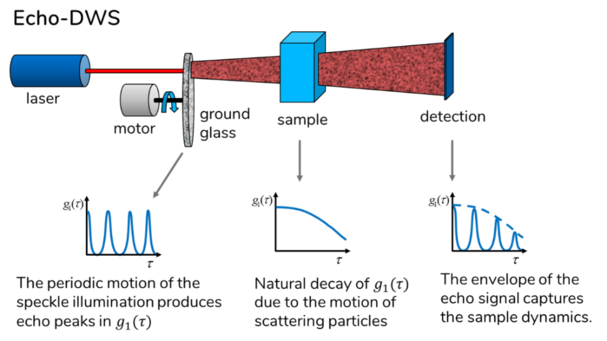Echo DWS
Many samples of industrial relevance such as paints, dairy products, or cosmetic formulations are often viscoelastic solids. Such samples can display very high viscoelastic moduli and very slow relaxations dynamics. The time-averaging mechanism of the classical DWS microrheology measurement does not allow the measurement of such important samples as their partially arrested dynamics prevent them from exploring over time all the possible states required to deliver accurate time averages.
The patented Echo DWS technique as implemented in the DWS RheoLabTM was developed with the exact purpose of enabling fast and accurate microrheology measurements of slowly relaxing samples with high viscoelastic moduli.

These non-ergodic samples are in a partially dynamically arrested state and can only be characterized by performing a proper ensemble average.
To obtain proper statistics over this time range, within the Echo DWS technology, the so-called two-cell technique is employed: the laser light signal is led through an additional turbid scattering medium, the so-called “second cell” before reaching the sample.
In the DWS RheoLabTM, a rotating ground glass is used as a second cell. Its periodic motion is used to produce a recurring speckle illumination which artificially samples different configurations of the experiment and provides accurate and fast ensemble averaging, with a physically correct baseline and no distortion of the sample signal.

P. Zakharov, F. Cardinaux, and F. Scheffold, “Multispeckle diffusing-wave spectroscopy with a single-mode detection scheme” Phys. Rev. E 73, 011413 (2006)
More application examples
Our applications page provides examples of DWS applied to many systems of industrial relevance such as suspensions, emulsions, gels...etc.
However, not all soft-matter systems contain spherical particles. In these cases, the Generalized Stokes-Einstein relationship no longer applies, and one must adapt the modeling to the specific system. Foams and granular matter are two important classes of optically dense soft materials that are often studied using DWS.
Foams are difficult to characterize optically due to strong light scattering. While one can artificially eliminate optical contrast in colloidal model systems by increasing the refractive index of the solvent to achieve ∆n≈0, this is not possible for foams. Here, DWS opens up an elegant possibility to follow the internal dynamics and evolution of the structure of bubbles, for example, in a shaving foam. Early on, people began to observe the slow dissolution of foams, in which the bubbles coalesce into larger and larger bubbles. This involved measuring the size of the bubbles, their movement, and restructuring.
Sand and other dry granular media are also of interest. In this case, the granular material is either shaken up or rendered liquid using a gas flow. Measurements have even been made recently in gravity-free conditions [1]. This allows us to investigate how granular media can be compacted and the dynamics that take place between the particles. The latter has consequences for the departure of avalanches or the formation of dunes.
Multiple light scattering is also studied in space. One example is the reflection of light from ice layers on moons and planets in our solar system. Here, too, interference effects such as coherent backscattering play an important role. Interestingly, this was first discovered in the laboratory on colloidal suspensions [2] and later used to interpret measurement data from telescopes and space missions. A similar approach is still used in space research today. Measurements on micro snow crystals have recently been simulated in the laboratory to achieve a better understanding of the situation in space, which could be of importance, for example, for the JUICE (JUpiter ICy Moon Explorer) mission to the icy moons of Jupiter planned by ESA [3] (see Physics in Our Time 2020,51(1), 2).
References:
[1] P. Born, J. Schmitz, M. Sperl, npj Microgravity 2017, 3.1, 27.
[2] P. E. Wolf, G. Maret, Phys. Rev. Lett. 1985, 55(24), 2696.
[3] B. Jost et al., Icarus. 2016, 264, 109; https://t1p.de/ESA-JUICE
